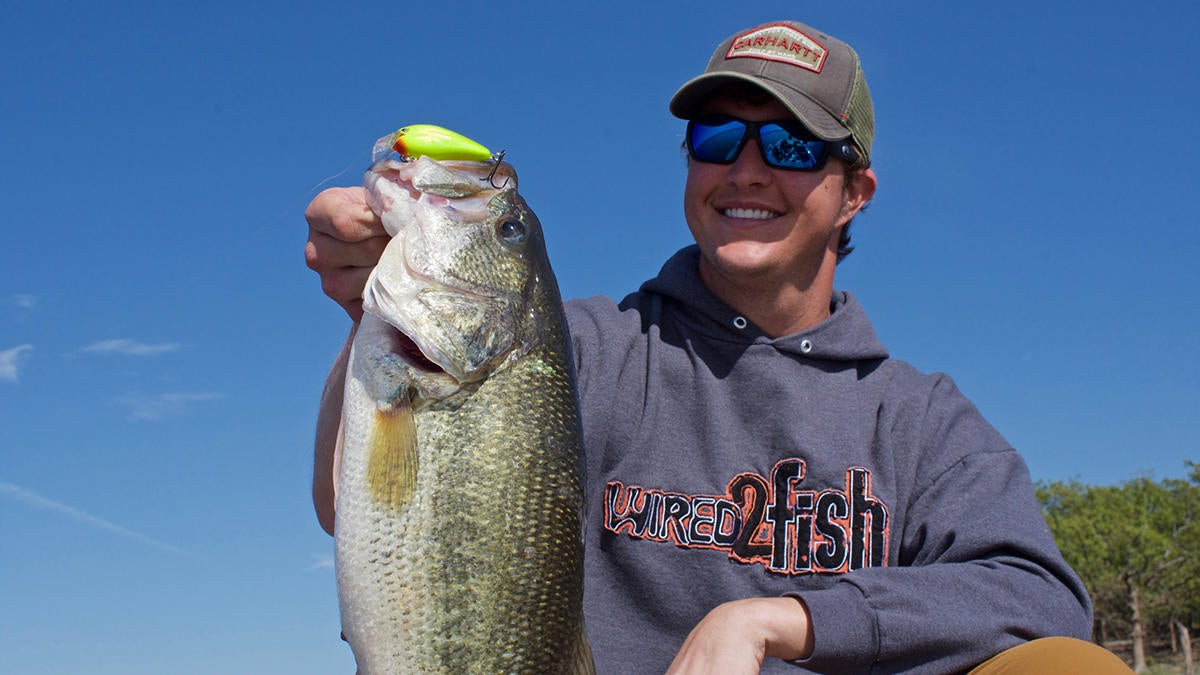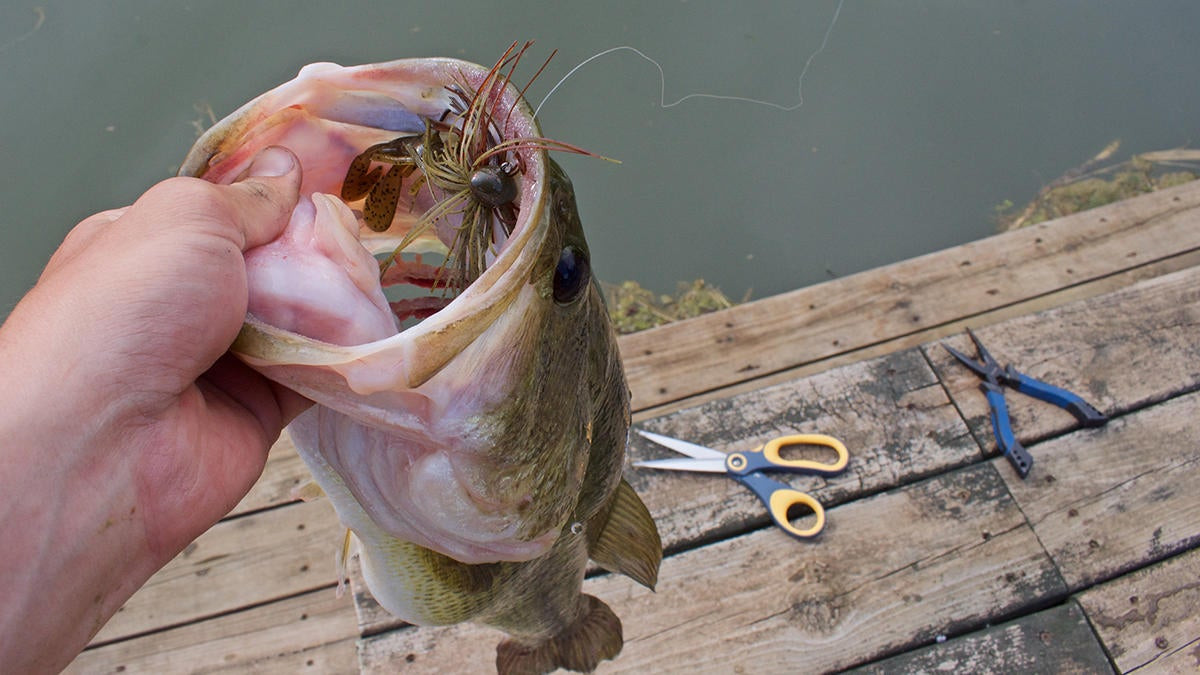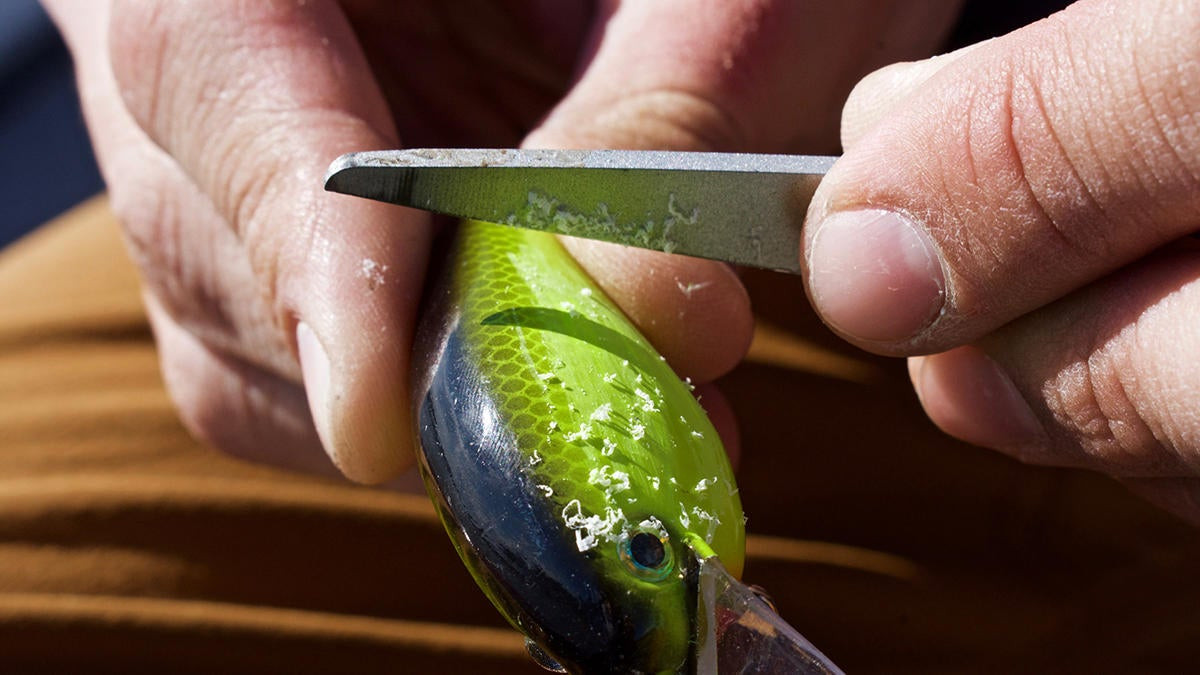Every bass angler’s tackle box should include scissors. Whether you invest a few dollars to ensure you own a quality pair that’ll hold up to the elements or you go through a cheap dollar store set each year doesn’t matter too much, as long as scissors are in the boat or with your fishing equipment.
Sure scissors are great for cutting fishing line, ropes or maybe even a piece of clothing an errant treble hook snags, but scissors are a tool to help you catch more bass, too. In bass fishing we are continually looking for ways to give ourselves an advantage over other anglers or tweaks that’ll up our chances of fooling more fish into biting.
There are surely more out there, but we’ve nailed down three easy tackle tweaks you can perform with a simple pair of scissors to give your bait a different look than similar baits pulled right from the package. These subtle changes help set your offering apart and provide the ever-elusive edge for which anglers are always searching.
Skirt trimming
Trimming jig skirts is not only an effective modification; it is practically a necessity if you ask most professional fishermen. Giving your jig a quick haircut with a pair of scissors takes about 5 seconds but the improvements are impactful. Modifying a jig skirt provides a wide range of benefits including changing the bulk or overall size of your jig, affecting its fall rate and how the jig behaves underwater.
Each application takes a slightly different method when it comes to how much and where exactly you cut the jig strands, but most pros agree trimming is a necessary step when they pull a jig from its package. The benefits of clipping a skirt with a pair of scissors don’t stop with flipping or football jigs though. Essentially all bass lures dressed with a skirt are fair game, including spinnerbaits, buzzbaits, bladed jigs and especially topwater frogs.
Most topwater frog legs are made from strands of living rubber. I always clip least one of those legs shorter whether I’m fishing open water or over the top of vegetation with a frog thanks to a lesson from Major League Fishing pro Jordan Lee.
“Trimming the legs of a hollow body frog is super important,” Lee said. “If I want to walk a frog in open water I’ll cut one of the legs about an inch shorter and leave the other alone. The legs add a lot of action to the frog, but the unevenness makes it easier to walk with soft, easy rod twitches. If I’m fishing around grass I trim both legs pretty tight to the body. I want my bait to be as compact as possible coming over those fishes heads to give them a target that’s hard to miss.”
Soft plastic modification
Modifying soft plastics is another application scissors are perfect for. Most of the time soft plastics are ready to be rigged and fished right when you pull them out of the bag. Like with any lure however, there are occasional circumstances when a more nuanced movement is needed. Thankfully, soft plastics are easy to tinker with.
There are a myriad of ways you can change a soft plastics action with a pair of scissors. You can cut off extra appendages that add unnecessary bulk or too much movement underwater in a certain scenario. Or you can amplify a bait’s action with different cuts that cause your lure to displace more water and have increased motion on your retrieve.
I learned how emphatic simple soft-plastic modification could be from Team Toyota pro Terry Scroggins. Scroggins is constantly tinkering with plastics and testing their movement in his swimming pool. One night I witnessed Scroggins go through two-dozen finesse worms before dialing in on a small angled cut that produced his desired action. As trivial as the adjustment seemed to me, Big Show used the tailored worms to catch the fire out of St. Johns River bass the very next day.
Whether you’re accentuating a bait’s action or trying to give it a more subtle appearance the key is this process makes a soft plastic unique. While it’s certainly not necessary to modify all your soft plastics, it’s a good tool to have in your bag of tricks if the situation arises when you need to show the fish something slightly different.
Give crankbaits a different look
A third way scissors can be used to alter a bait and help it stand out is to use the edge of a scissor blade to change the look of a crankbait’s paint job. With steady hands and a little finesse you can take the outer layer of paint off loud, intrusive crankbait color schemes with ease.
The ideal color doesn’t exist in bass fishing but instead changes day-by-day, even hour-by-hour, based on weather conditions, water clarity and primary forage. You might smash ’em on a bright chartreuse crankbait one day, but find the fish slapping and missing the bait a few days later. Taking a pair of scissors and muffling a crankbait’s color by shaving off the bright outer layer of paint might save you from having to swap out baits or colors altogether.
I discovered this tackle tweak years ago after reading a Wired2fish article about sanding crankbaits and sun-baking crankbaits to give them a custom paint job. I was fixated on the idea of dulling the loud colors on some of my crankbaits but I was a broke college freshman with no vehicle on campus; and admittedly didn’t possess the patience required to wait weeks at a time for the sun to work its magic.
So I grabbed a pair of scissors and was pleasantly surprised with how effective they were for the job. Full transparency, you can also use a pocketknife (or sandpaper) to perform this modification, but I’ve found scissors to be the easiest and safest. The dull edge of a scissor blade is perfect for scraping off the top layer of flashy paint without cutting yourself or ruining the action of the plug in the process.
Knowing how to get the most of out of your equipment and using the tools available is always in a fisherman’s best interest. Scissors should absolutely have a home in your tackle box and are an effective means for far more than cutting excess fishing line. Add these tackle modifications to your repertoire, don’t be afraid to tinker with your tackle, and never stop learning.














